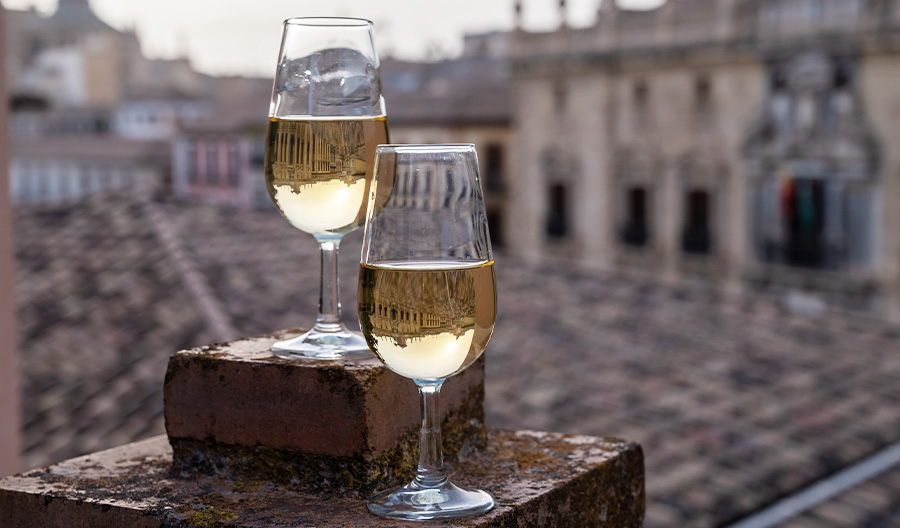Sherry wines, originating from the Andalusian region of Spain, are a diverse group of fortified wines that vary greatly in terms of flavor, color, and aging process. The primary types of sherry wines include Fino, Manzanilla, Amontillado, Oloroso, Palo Cortado, Pedro Ximénez, and Moscatel.
Fino is the lightest and driest type of sherry. It is aged under a layer of yeast called 'flor' which prevents it from coming into contact with air, giving it a pale color and a fresh, tangy flavor. Fino is typically served chilled and pairs well with seafood and tapas.
Manzanilla is similar to Fino in terms of its lightness and dryness, but it is produced in the coastal town of Sanlúcar de Barrameda, which gives it a distinctive salty note. Like Fino, Manzanilla is aged under flor and is best enjoyed chilled.
Amontillado is a unique type of sherry that begins its life as a Fino or Manzanilla, but is later exposed to oxygen, resulting in a darker color and a richer, nuttier flavor. This dual aging process makes Amontillado a versatile wine that can be paired with a variety of foods.
Oloroso is a full-bodied sherry that is aged in the absence of flor, allowing it to come into contact with air and develop a dark color and intense, complex flavors of nuts and dried fruits. Oloroso is typically dry, but sweet versions are also produced.
Palo Cortado is a rare and highly valued type of sherry that begins its life as a Fino or Amontillado, but unexpectedly develops characteristics similar to an Oloroso. This results in a wine that combines the delicate aroma of Amontillado with the full-bodied flavor of Oloroso.
Pedro Ximénez and Moscatel are sweet sherries made from sun-dried grapes, resulting in wines with a dark color and a rich, syrupy texture. Pedro Ximénez is characterized by flavors of figs, dates, and molasses, while Moscatel has a more floral and citrusy profile.

How is each type of sherry wine made?
Sherry wine production starts with the harvesting of Palomino grapes, which are then pressed to extract the juice. The juice is fermented in stainless steel vats, producing a young wine known as 'mosto'. This mosto is then classified based on its characteristics, with the lighter, more delicate wines destined to become Fino or Manzanilla, and the fuller-bodied wines set to become Oloroso.
The production of Fino and Manzanilla involves the formation of a layer of yeast, known as 'flor', on the surface of the wine. This flor protects the wine from oxidation and imparts unique flavors. The wine is fortified to about 15% alcohol to support the growth of flor. It is then aged in a system of barrels known as the 'solera', where it is gradually blended with older wines.
Manzanilla is essentially a type of Fino, but it is made exclusively in the coastal town of Sanlúcar de Barrameda. The unique microclimate of this region encourages a thicker, more robust flor, resulting in a lighter, more delicate sherry with a slightly salty tang.
Amontillado is initially aged under flor like a Fino, but at a certain point, the flor begins to die off, and the wine starts to oxidize. It is then fortified to a higher alcohol level, which kills off the remaining flor, and the wine is aged oxidatively. This results in a sherry that combines the nutty flavors of a Fino with the richer, more complex flavors of an Oloroso.
Oloroso sherry is made from the mosto that is too full-bodied to develop flor. It is fortified to about 17% alcohol, which prevents the growth of flor, and then aged oxidatively. This results in a rich, dark, and complex sherry with flavors of dried fruit, nuts, and spices.
Palo Cortado is a rare type of sherry that starts its life as a Fino or Amontillado, but mysteriously loses its flor and begins to oxidize like an Oloroso. The exact reasons for this are still not fully understood, but the result is a sherry with the delicate aroma of an Amontillado and the full-bodied richness of an Oloroso.
Pedro Ximénez and Moscatel are sweet sherries made from grapes of the same name. The grapes are sun-dried to concentrate their sugars, then pressed and fermented. The resulting wine is fortified and aged oxidatively. These sherries are intensely sweet and syrupy, with flavors of dried fruit, honey, and spices.
What regions are known for producing specific types of sherry?
Sherry is primarily produced in the region of Andalusia in Southern Spain. This region is known for its unique climate and soil which contribute to the distinctive characteristics of sherry wines. The 'Sherry Triangle', formed by the towns of Jerez de la Frontera, Sanlúcar de Barrameda, and El Puerto de Santa Maria, is the most notable area within Andalusia for sherry production.
Jerez de la Frontera is the heartland of sherry production. It's particularly known for producing Fino and Oloroso styles of sherry. Fino is a dry, light-bodied sherry, aged under a layer of yeast known as 'flor' that imparts a unique, fresh flavor. Oloroso, on the other hand, is a full-bodied sherry, aged oxidatively to develop a rich, nutty flavor.
Sanlúcar de Barrameda, located on the coast, is famous for its Manzanilla sherry. This is a type of Fino sherry that develops a distinctive salty, tangy character due to the town's maritime climate. The flor in Sanlúcar de Barrameda is thicker, which leads to a lighter, more delicate flavor in the Manzanilla sherry.
El Puerto de Santa Maria, also coastal, is known for its Fino sherry, often referred to as Puerto Fino. The town's seaside location contributes to a slightly fuller, more rounded flavor profile compared to the Fino from Jerez. The region's warmer climate and higher humidity levels also influence the taste of the sherry.
Outside of the Sherry Triangle, Montilla-Moriles, a region located in the province of Cordoba, is known for its production of Pedro Ximénez sherry. This is a sweet, dessert-style sherry made from sun-dried Pedro Ximénez grapes, resulting in a rich, raisin-like flavor.
Lastly, the region of Chipiona is known for Moscatel sherry, another sweet style of sherry. This region's sandy soils and sunny climate are ideal for growing Moscatel grapes, which are used to produce a sherry with a fragrant, floral aroma and a sweet, honeyed taste.

